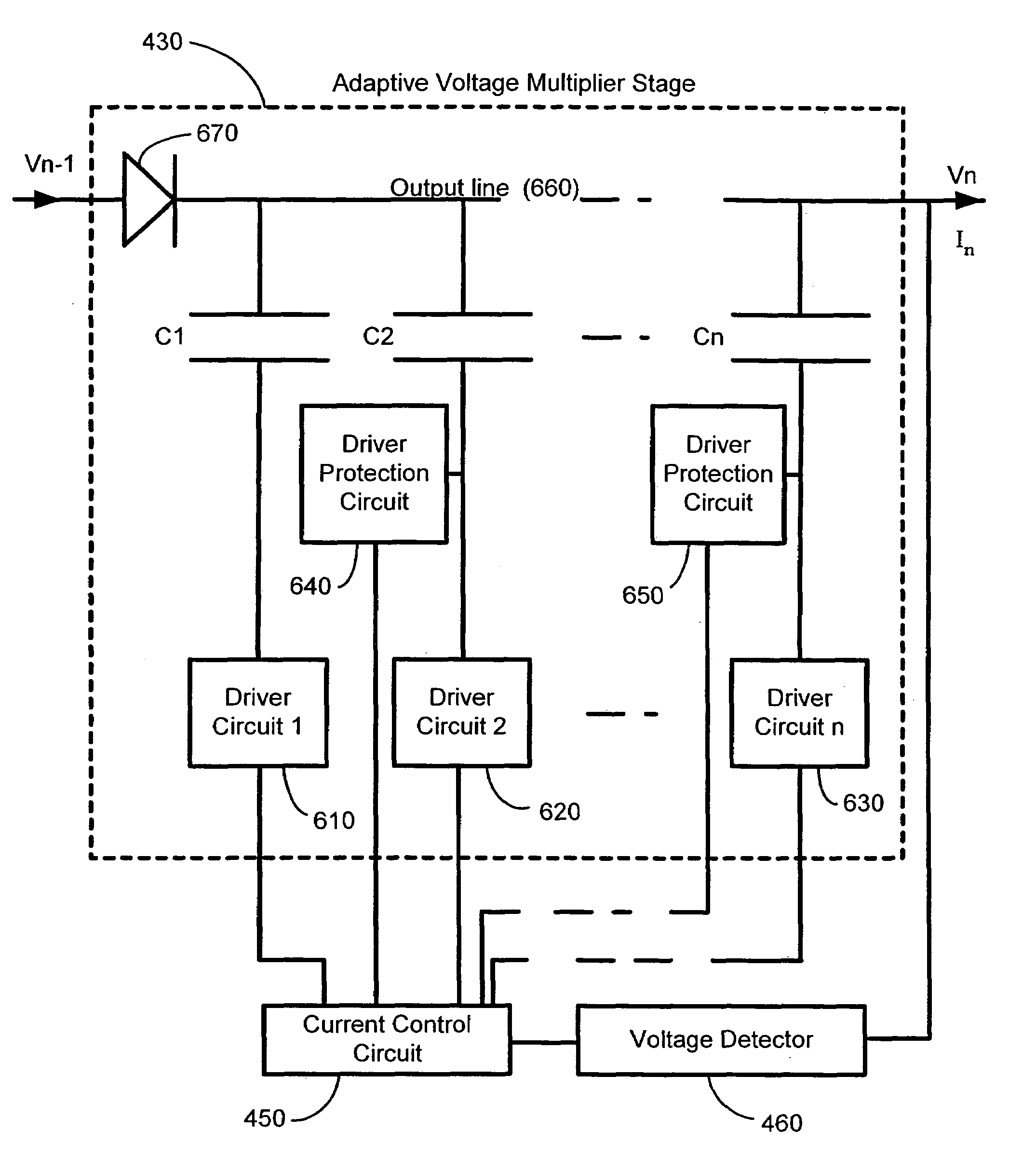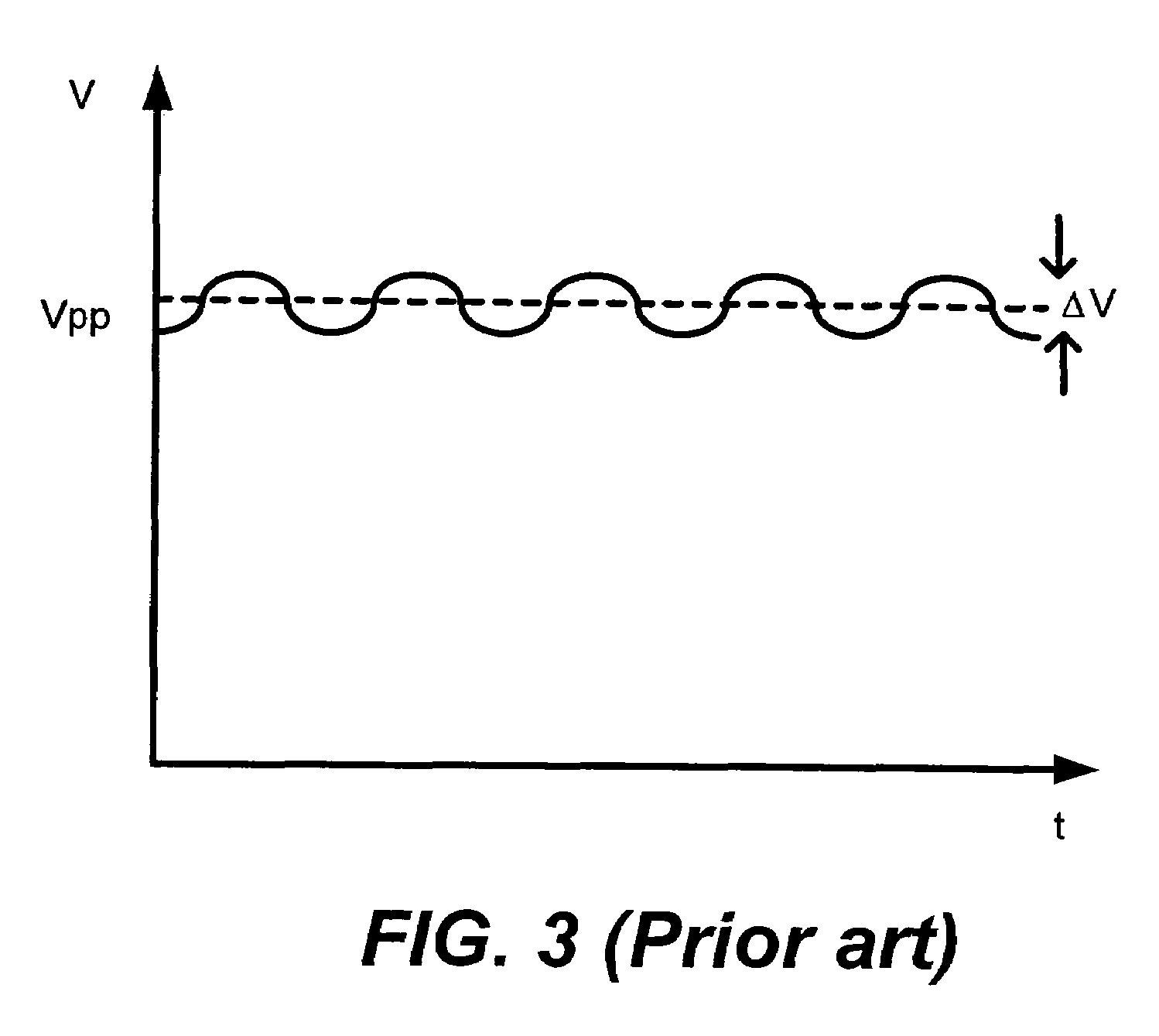High voltage ripple reduction and substrate protection
- Summary
- Abstract
- Description
- Claims
- Application Information
AI Technical Summary
Benefits of technology
Problems solved by technology
Method used
Image
Examples
first embodiment
[0037]FIG. 6 illustrates schematically the present invention. This is an adaptive voltage multiplier stage 430 with controlled current output. This stage has a diode 670 and several capacitors C1–Cn connected in parallel instead of the single capacitor C of the prior art shown in FIG. 2. Each capacitor C1–Cn has a corresponding driver circuit 610–630. These capacitors may be enabled or disabled by the current control circuit 450 in response to a signal from the voltage detector 460. Enabled capacitors operate like the capacitor C of FIG. 2. Disabled capacitors are no longer active in the voltage multiplier stage. By disabling capacitors, the capacitance used in the adaptive voltage multiplier stage may be reduced. This reduces the charge stored according to the equation: Q=CV. With less charge stored, less charge is pumped from the stage on each clock cycle. The result is less charge pumped per unit time, that is, less current output.
[0038]Drivers for disabled capacitors do not supp...
second embodiment
[0040]FIG. 7 illustrates the present invention. This embodiment provides a second means to control the current output by using an adaptive driver circuit 700. This may be used in place of the driver circuit shown in FIG. 2, or driver circuit 1610 of FIG. 6. This is a driver circuit that has two possible levels of output voltage. The voltage supply, Vcc, goes to two transistors, T1 and T2. The first transistor, T1, is configured to provide a high voltage (approximately Vcc) at node N1. Transistor T1 is controlled by the current control circuit 450. It is turned on in mode 1, and turned off in mode 2. The second transistor, T2, is configured to provide a lower voltage at node N1 when T1 is turned off. The gate of T2 is controlled by the clamp regulation circuit 710 to provide a constant, low voltage at N1. This, in turn, lowers the output of the driver circuit. The effect of providing a lower voltage to the capacitor is to drive less charge through the stage on each clock cycle. There...
third embodiment
[0043]FIG. 9 illustrates a driver circuit of the This is a switchable adaptive driver circuit 900. This may be used as driver circuit 2–-driver circuit n (620–630) in FIG. 6. This circuit is similar to the adaptive driver circuit 700 shown in FIG. 7. It has two parallel voltage supplies from Vcc. One branch is controlled by the current control circuit 450 to provide a high voltage output in mode 1. The other branch is regulated by the clamp regulation circuit 710 to provide a reduced voltage output in mode 2. However the transistors in this circuit are arranged so that T7 and T8 are directly connected to the driver output. The driver output is susceptible to voltages coupled through the capacitor when the capacitor is disabled. Transistors T7, T8 and T9 are all N-channel devices and so only N-channel devices are directly connected to the driver output in this configuration. This allows the driver output voltage to be held at a particular voltage level that is selected to reduce the...
PUM
 Login to View More
Login to View More Abstract
Description
Claims
Application Information
 Login to View More
Login to View More - R&D
- Intellectual Property
- Life Sciences
- Materials
- Tech Scout
- Unparalleled Data Quality
- Higher Quality Content
- 60% Fewer Hallucinations
Browse by: Latest US Patents, China's latest patents, Technical Efficacy Thesaurus, Application Domain, Technology Topic, Popular Technical Reports.
© 2025 PatSnap. All rights reserved.Legal|Privacy policy|Modern Slavery Act Transparency Statement|Sitemap|About US| Contact US: help@patsnap.com



